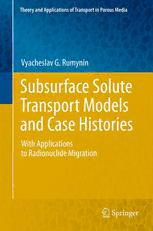Table Of ContentSubsurface Solute Transport Models
and Case Histories
TheoryandApplicationsofTransportinPorousMedia
SeriesEditor:
JacobBear,DepartmentofCivilandEnvironmentalEngineering,
Technion – Israel Institute of Technology, Haifa, and School of Engineering,
KinneretCollegeontheSeaofGalilee,Israel
Volume25
Forfurthervolumes:
http://www.springer.com/series/6612
Vyacheslav G. Rumynin
Subsurface Solute Transport
Models and Case Histories
With Applications to Radionuclide Migration
ABC
VyacheslavG.Rumynin
TheRussianAcademyofSciences
InstituteofEnvironmentalGeology
SaintPetersburgDivision
SaintPetersburgStateUniversity
GeologicalDepartment
SredniyAve.,41,of519
199004St.Petersburg
RussianFederation
[email protected]
This book is a revised and updated version of the book in Russian Geomigracionnye
modeli v gidrogeologii (Geomigration Models with Application to Groundwater
Hydrology), by Vyacheslav G. Rumynin, published by “Nauka” (“Science”) Publisher,
St.Petersburg,2009,ISBN978-5-02-025140-3.
ISBN978-94-007-1305-5 e-ISBN978-94-007-1306-2
DOI10.1007/978-94-007-1306-2
SpringerDordrechtHeidelbergLondonNewYork
LibraryofCongressControlNumber:2011930258
(cid:2)c SpringerScience+BusinessMediaB.V.2011
Nopartofthisworkmaybereproduced,storedinaretrievalsystem,ortransmittedinanyformorby
anymeans,electronic,mechanical,photocopying,microfilming,recordingorotherwise,withoutwritten
permissionfromthePublisher,withtheexceptionofanymaterialsuppliedspecificallyforthepurpose
ofbeingenteredandexecutedonacomputersystem,forexclusiveusebythepurchaserofthework.
Coverdesign:deblik
Printedonacid-freepaper
SpringerispartofSpringerScience+BusinessMedia(www.springer.com)
Preface
Studiesofsolutefateandtransportinthesubsurfaceenvironmenthavebeenplaying
asignificantroleinhydrogeologyoverthepasthalfcentury.Theproblemdirectly
relates to the quality of natural water resources, which are essential to all kinds
oflife, andare a basic elementin manysectorsof humansociety.Mostmigration
studies of both naturaland anthropogenicallyderivedspecies have consideredthe
motionofafluid(groundwater)accompaniedbydiffusion–dispersionphenomena,
physicochemicalinteractions,aswellasmicrobiologicaltransformations,knownto
be the dominant factors providing the impact of contaminants upon groundwater
supplies.
Overthelastdecades,essentialprogressinthemigrationprocessdescriptionhas
beenachievedduetothedevelopmentofmathematicalbackgroundandnumerical
methodsandlaboratoryandfieldinvestigationsofparticulartransportmechanisms
andphysicochemicalinteractions.However,inmanyrealsituations,thesubsurface
materialheterogeneityandvariationsinfluidproperties,resultinginnonlinearcon-
taminant plume behavior, make the prediction accuracy of the transfer processes
toolowtosatisfythepracticalneeds.Thelackofcomprehensivefieldstudiesofso-
lutemovementisoftencitedasamajorimpedimenttoourunderstandingofsolute
transportinsuchsystems.
Therefore,thisworkisaimedatthedevelopmentofthebasicknowledgeofthe
subsurface solute transfer with a particular emphasis on field data collection and
analysis coupled with modeling (analytical and numerical) tool application. The
book is based mostly on field materials from author’s long-standing, recent, and
current experience in the study of groundwater quality related problems. The di-
versity of these problems is concerned with the variety of geological settings as
well as the anthropogenic effects and processes caused by human activity. Some
problemsencounteredinpracticelookedaschallenge-likeand,thus,theauthorwas
encouraged to search for new solutions and approaches. The relevant theoretical
developmentsareconcernedmainlywiththeformulationandsolutionofdetermin-
isticmass-transportequationsforawiderangeofengineeringissuesingroundwater
qualityassessmentandforecastingthatcanbeofsomeinterestforbridgingthegaps
stillexistinginourknowledgeofcontaminanthydrogeology.
The book gives many computation examples and case studies drawn from the
conductedfieldinvestigations.Thoseexamplesshowtheapplicabilityofthetheory
v
vi Preface
and methodsfor solving variouspractical problemsand making decisions in con-
taminanthydrologytoexplaintheobservedandtoforecastthefuturegroundwater
quality.Theanalyzedproblemsareasfollows:
(1) investigation and prediction of groundwater contamination by industrial con-
taminantsandsolutions(radionuclides,chlorideandnitratebrine)withspecial
focus on the effect of (a) aquifer heterogeneity,anisotropy,and dual porosity,
(b) density contrast between industrial waste and groundwater, (c) physico-
chemical interactions that play a major role in retarding (e.g., adsorption) or
enhancing (e.g., interactions between dissolved species and mobile colloids)
contaminanttransport;
(2) prediction of the effects of pumping on groundwater quality at wellfields:
(a) the displacement of stratified initial concentration in artesian and coastal
(off-shore)groundwater systems due to water pumping, (b) downward move-
ment of mineral-weatheringproducts in the vadoze zone (above the lowering
watertable)withwaterrechargetotheproducingaquifers;
(3) groundwater dating using stable and radioactive isotopes for prediction and
assessment of contamination potential and the time that would be needed to
displacecontaminantsfromthegroundwatersystem;
(4) fieldandlaboratorytests’ designandanalysis,andmonitoringdatainterpreta-
tion;
(5) partitioningofsurfaceandsubsurfaceflowsusingisotopetechnique;
(6) formationofevaporatedsaltdepositsinclosedsurfacewaterreservoirshaving
ahydraulicconnectionwiththesurroundinggroundwatersystems.
Severalpartsofthebookdemonstratethepotentialforusingnumericalground-
water flow and transport models in environmental risk assessment of subsurface
contaminationbydenseorlightmiscibleliquidwaste.Environmentalisotopedata
were utilized for defining the groundwater systems and modeling data analysis.
However, numerical modeling emerged in the book mostly as one of the primary
toolsusedtounderstandthemostimportantphysicalandphysicochemicalprocesses
thatoccuringroundwatersystems,aswellasforgettinganalyticalapproximations
forsomecoupledproblems,whichdonotnecessarilyhaveexactsolutionsinclosed
analyticalformsorcannotbetreatedwiththeclassicalmethods.
Oneofthemostessentialtopicsaddressedinthebookisthemigrationandfateof
radionuclides.Modeldevelopmentismotivatedbyfielddataanalysisfromanumber
ofradioactivelycontaminatedsitesintheRussianFederation:near-surfaceradioac-
tivewaste (RW)disposalsitesinnorthwesternRussia andtheSouthernUrals,and
two deep-well RW injection sites in Western Siberia. These sites are partof huge
nuclear industry enterprises licensed to possess radioactive materials and also in-
volvedinhazardous-wasteoperations,whicharesupervisedbyRosAtom,theState
NuclearEnergyCorporation,RussianFederation.
Thetotalactivityofradionuclidesthatwerereleased(accidentallyorintention-
ally) in aquifers at many sites reaches hundredthousands to hundredmillions Ci.
AnyofthethreeRWdisposalsitesoutofthefourmentionedhere(locatedinSouth-
ern Urals and Western Siberia) probablycontains more radioactive contamination
Preface vii
inthesubsurfacethananyothersiteintheworld.Additionally,detailedinformation
onphysical,mechanical,andsolutetransferpropertiesofclayformation(whichis
consideredasahostmediumfortheengineeredundergroundRWrepositoryinthe
northwesternpartoftheRussianFederation)isalsoanalyzed.
Thosesitesplayauniqueroleintheadvancementofknowledgeofthesubsurface
behaviorandfateofmanyhazardousradionuclidesandcanbeconsideredasfield-
scalelaboratories.Thebookisfocusedonthemodelingandanalyticalassessments
ofarangeofphysicalandchemicalprocessesandinteractionsofconcern.Someof
thekeyissuesneededtobeaddressedincluded:
(1) studyofthebehaviorofabroadspectrumofradionuclides(fissionproductsand
actinides) in waste (with low content of dissolved solids and brine) based on
long-term(upto50years)monitoringdatainshallowanddeepaquifersystems;
(2) studyofthespatialvariabilityofmigrationpropertiesofaquifermaterialsand
clayeysemiperviousformations;
(3) assessmentoftheroleofbrine-inducedadvectioninredistributionofradioactive
componentsatwastedisposalsites;
(4) studyofadsorptionhysteresisimplyingisothermnonsingularityandothernon-
ideal sorption phenomena, as well as the assessment of their role in natural
attenuationofradioactivelycontaminatedsites;
(5) analysisoftransienthydrogeochemical-barriereffects,facilitatingradionuclide
transport,andsomeothermechanismsresponsiblefor“fast”radionuclidetrans-
portinaquifers;
(6) experimentalevidence for colloid-facilitated radionuclide(actinide) transport,
andmathematicaldescriptionofthephenomena.
The model developmentswere accompanied by laboratory studies into natural
attenuation, radionuclide adsorption and desorption kinetics and equilibrium (in-
cluding when colloidal particles are involved). Batch tests were conducted with
differentradioactivesolutionsunderdifferenttemperatureandpressureconditions.
Anomalousbehaviorofradionuclideswasobservedandmodeled.
Thisstudycanberegardedasthecontinuationofaseriesofworksstartedbythe
authorinthe1970sincooperationwiththeoutstandingRussianscientist,hydroge-
ologist,V.A.Mironenko,whosecontributiontothedevelopmentofseverallinesof
studiesinhydrogeologyandhydrogeomechanicsisdifficulttooverestimate.Atthe
sametime,thisbookcouldnotappearedwereitnotfortheall-roundsupportfrom
colleagues–researchersfromE.M.SergeevInstituteofEnvironmentalGeology,St.
PetersburgDivision,RAS,andSt.PetersburgStateUniversity,whorenderedassis-
tance in the preparation of parts of the book. In this connection, the author very
much appreciatesthe help of Leonid Sindalovsky in implementationof many nu-
mericalalgorithmsconsideredinthebook,thecontributionofPavelKonosavskyto
the joint studies of adsorption hysteresis and the developmentof some models of
solutetransferintheporousmediaunderdisturbedflowconditions.Theauthoralso
appreciatesIgorTokarev’swillingnesstosharehisdataonregionalisotopestudyof
agroundwatersystemintheareaofRWdisposalatTomsk-7site.
viii Preface
The study discusses experiments carried out in laboratories of A.N. Frumkin
Institute of Physical Chemistry and Electrochemistry, RAS, and A.P. Alexandrov
TechnicalInstituteundersupervisionofDrs.ElenaZakharova,ElenaKaimin,and
ElenaPankina.Theauthorexpresseshissinceregratitudetothesegroupsforcoop-
erationthathaveyieldednewresults.
The author appreciatesthe cooperationof Aretech Solutionsand TIHGSA En-
terprisesallowinghimtolearnnewhydrogeologicalaspectsrelatedtotheformation
ofgroundwaterresourcesandqualityinaridregions.
The author also much appreciates the attention to his work and fruitfull dis-
cussions with Profs.Vsevolod Shestakov and Sergey Pozdniakov, Moscow State
University, and Dr. Andrei Zubkov, the head of the EnvironmentalProtection Di-
vision(SiberianChemicalPlant),andmanyotherbrilliantexperts–hydrogeologists,
whosetalentandenthusiasminscientificandproductionworkallowstheauthorto
believeinthefutureoftheRussianhydrogeologicalschool.
ManyeffortsweremadebyDr.Chin-FuTsangandProf.JacobBeartoorganize
thisworkinaproperwayinordertopreparethebookinaformatacceptableforthe
internationalpublishingcompany,Springer.Discussionsandexchangeofinforma-
tion,ideas,andopinionswiththemwasagreatsupporttothiswork.
Finally,theauthorverymuchappreciatesthehelpofDr.GennadyKrichevetsin
professionaltranslationofthebookandmanyusefulcommentsfromhimallowing
theauthortomakecertainimprovementstothebook.Theauthorwouldalsoliketo
acknowledgethehelpofEkaterinaKaplanforhereditorialassistanceandtechnical
supportofthework.
Thus,thebook,alongwiththeoreticalfindings,containsfieldinformation,which
willfacilitatetheunderstandingofsubsurfacesolutetransportandthedevelopment
of a methodology for practical application to groundwater hydrology. This book
addressesscientistsandengineerswhoareinterestedinthequantitativeapproachto
studyinggroundwatermigrationprocesses.Thebookcanalsobeprofitablyreadby
students.
December28,2010 VyacheslavG.Rumynin
Contents
PartI TheEssentialsofDissolvedSpeciesTransport
intheSubsurfaceEnvironment:BasicDefinitions,Fundamental
MechanismsandMathematicalFormulation
1 AdvectionandDispersionofDissolvedSpeciesinAquifers ............. 3
1.1 GoverningEquationsandSoluteTransportParameters.............. 3
1.1.1 Advectionof ConservativeComponents
inPorousandFracturedMedia .............................. 4
1.1.2 MolecularDiffusionand Hydrodynamic
Dispersion(Microdispersion)................................ 11
1.1.3 InitialandBoundaryConditions;Definitions
ofConcentrationFunctions .................................. 18
1.2 ModelsforAdvectiveTransportinHomogeneous
IsotropicMedia......................................................... 20
1.2.1 ACharacteristics-BasedMethodforSolving
theTransportEquations...................................... 20
1.2.2 Solute Transport Process Analysis
inCurvilinearCoordinates................................... 24
1.3 AOne-DimensionalModelofMicrodispersion...................... 33
1.3.1 SolutionsforInfinitePorousDomain........................ 34
1.3.2 A Basic (Fundamental) Solution
forSemi-InfinitePorousDomain............................ 36
1.3.3 On the Solutionand Analysis of Solute
TransportProblemsbyApplyingtheLaplaceTransform .. 38
1.3.4 Quasi-One-Dimensional Solution
ofMicrodispersionProblemsinDeformed
FlowsinPorousMedia....................................... 45
1.4 Spatial (2D and 3D) Modelsof Microdispersion
inUnidirectionalSteady-StateFlow .................................. 46
1.4.1 BasicSolutionsforaPointSource........................... 47
1.4.2 ApproximateSolutionsfor2Dand3DSolute
TransportProblems........................................... 50
1.4.3 Steady-StateAsymptotics.................................... 52
ix
x Contents
1.4.4 ApproximateSolutionsforaFinite-SizeSource............ 54
1.4.5 ExactSolutionsfor3DProblem............................. 57
1.4.6 TheInfluenceofGeologicalBoundaries.................... 58
1.5 EquationsforSimplestChemicalReactionsandTransformations .. 60
1.5.1 Sorption....................................................... 60
1.5.2 Decay.......................................................... 64
References...................................................................... 70
2 WaterMovementandSoluteTransportinUnsaturated
PorousMedia.................................................................. 77
2.1 BasicSoil-WaterMovementandInfiltrationModels................. 78
2.1.1 GoverningFunctionsandParameters........................ 79
2.1.2 ContinuityEquationanditsMajorRepresentations ........ 85
2.1.3 ParticularSolutionsforMoistureMigration
andTheirAnalysis............................................ 88
2.2 OnModelsCouplingWaterInfiltrationandSoluteTransport .......106
2.2.1 Advection:ACharacteristicSolution........................107
2.2.2 DispersionDuringAdsorptionofWaterbySoil............111
2.2.3 Advection–DispersionTransport ............................114
References......................................................................116
PartII ConceptualModelsforRegionalAssessment ofSoluteTransport
(UnderHomogeneousLiquidFlowConditions)
3 One-DimensionalHydrodynamicMixing Models for
RegionalFlowSystemsUnderArealRechargeConditions
andTheirApplicationtotheInterpretationofIsotopicData ...........123
3.1 StableComponentMigration..........................................124
3.1.1 FlowandMassBalanceUnderConfinedFlow
Conditions ....................................................124
3.1.2 BasicAnalyticalSolutions...................................125
3.1.3 Correspondencewitha ReservoirModel:
TransitTimeandTransitTimeDistribution.................128
3.2 TransportofaSoluteSubjecttoFirst-OrderSingle-StageDecay ...131
3.2.1 BasicAnalyticalSolutions...................................131
3.2.2 VariableBoundaryConditions...............................132
3.3 MigrationofaSoluteSubjecttoChainDecay........................135
3.3.1 Two-Stage Chain Decay of an Unstable
Isotope Coming into an Aquifer with
InfiltrationRecharge..........................................136
3.3.2 Two-StageChain Decayin Aquiferwith
aRadioactiveElementinSolidsastheOnly
SourceofRadioactivity ......................................139
3.3.3 Two-MemberChainDecayinAquiferSolids
ContainingSeveralRadioactiveElements...................141

